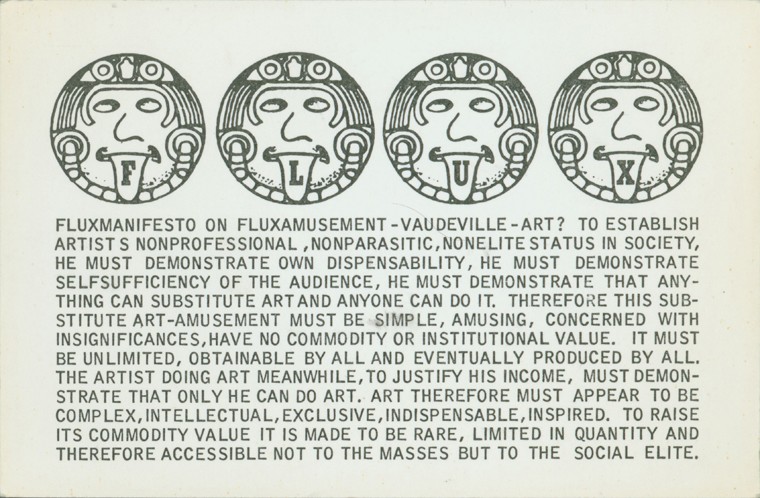Thea Djordjadze and George Maciunas

Contemporary Art Museum St Louis
FEB 22 , 2011 – March 20 , 2011
Best known as the founder and central organizer of the international artists’ collective Fluxus from 1962 until his death in 1978, the Lithuanian-born American artist George Maciunas extended art and the role of the artist beyond conventional boundaries. Maciunas produced a dizzying array of objects, performances, plans, posters, charts, atlases, newspapers, and other ephemera that cut across art, art history, world history, architecture, design, typography, musicology, film, editing, publishing, genealogy, systems and organizational thinking, and pedagogy. His innovative graphic design gave Fluxus its unique visual identity. Flux Products were branded as “anti-commodities.” Everything Maciunas did was informed by a philosophy of economy: greatest use-value for the least cost. He loved the simplicity of Vaudeville and the films of Buster Keaton, and wanted Fluxus to have the expulsive power of a good joke. Fluxus works were unpretentious, amusing yet thought provoking, and obtainable by everyone. Ultimately, he believed, aart should be something anyone can do. A small selection of Maciunas’ graphic design, charts, ephemera and films will be presented in and around The Front Room at CAM St. Louis.
With support from Harry Stendhal and George Maciunas Foundation inc


Thea Djordjadze
From the minimal architectural gestures, hand-molded plaster forms, shadow boxes, and draped tapestries that form her delicate installations, the constructed environments of Georgian-born, Berlin-based Thea Djordjadze reveal an incisive practice of spatial investigation. Her body of sculptures, objects and installations are often marked by a metaphysical pursuit, testing the nature of the mind and memory, and bringing the viewer’s attention to the conditions of space, time, and the body. For her first exhibition in the U.S., Djordjadze will travel to St. Louis to create an installation of new works on site in The Front Room. Her intimate, amorphic sculptures made from plaster, wood, textiles, wire and linoleum, hint at domesticity while privileging process and an awareness of the potential authority and phenomenology of the art object. Found objects, carpets, and lamps make their way into her installations as well, revealing an archaeological tenor, as she excavates shapes, materials, textiles, images, and objects to trace the current manifestations of historical ideologies and events.

Best known as the founder and central organizer of the international artists’ collective Fluxus from 1962 until his death in 1978, the Lithuanian-born American artist George Maciunas extended art and the role of the artist beyond conventional boundaries. Maciunas produced a dizzying array of objects, performances, plans, posters, charts, atlases, newspapers, and other ephemera that cut across art, art history, world history, architecture, design, typography, musicology, film, editing, publishing, genealogy, systems and organizational thinking, and pedagogy. His innovative graphic design gave Fluxus its unique visual identity. Flux Products were branded as “anti-commodities.” Everything Maciunas did was informed by a philosophy of economy: greatest use-value for the least cost. He loved the simplicity of Vaudeville and the films of Buster Keaton, and wanted Fluxus to have the expulsive power of a good joke. Fluxus works were unpretentious, amusing yet thought provoking, and obtainable by everyone. Ultimately, he believed, art should be something anyone can do. A small selection of Maciunas’ graphic design, charts, ephemera and films will be presented in and around The Front Room at CAM St. Louis.

Thea Djordjadze is curated by Mel Trad. George Maciunus is curated by Mari Dumett.

Sponsors
Major exhibition support is provided by Jeanne and Rex Sinquefield; William E. Weiss Foundation; and Nancy Reynolds and Dwyer Brown. General operating support is provided by Whitaker Foundation; Missouri Arts Council, a state agency; Missouri Cultural Trust; Regional Arts Commission; Bank of America Charitable Foundation; The Trio Foundation of St. Louis; Arts and Education Council; and members of the Contemporary Art Museum St. Louis.
